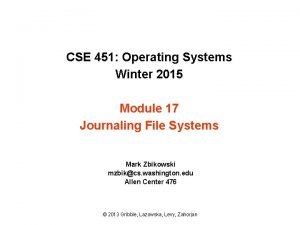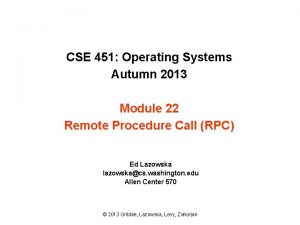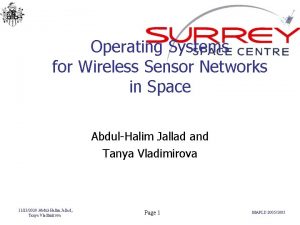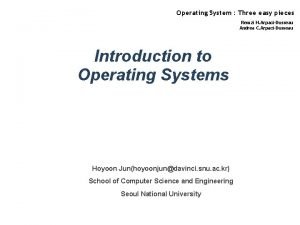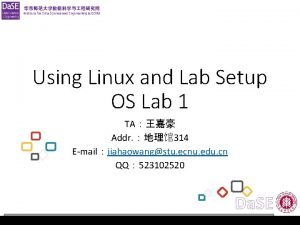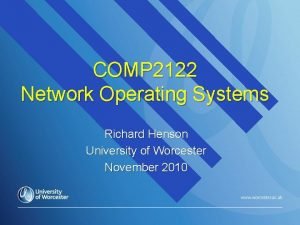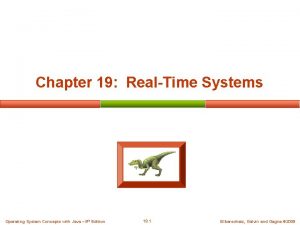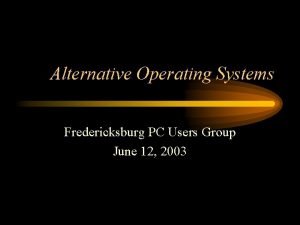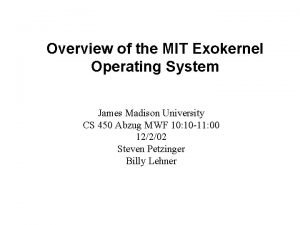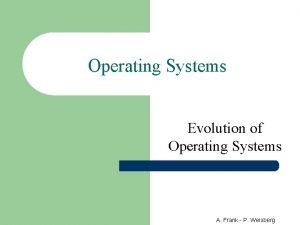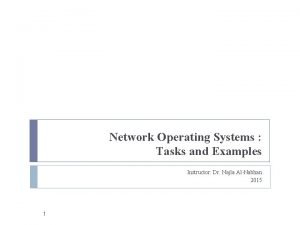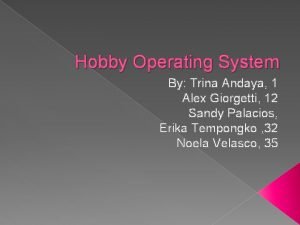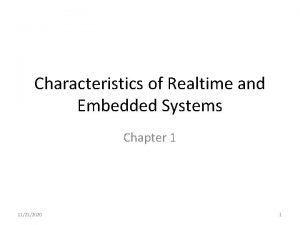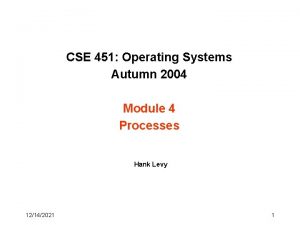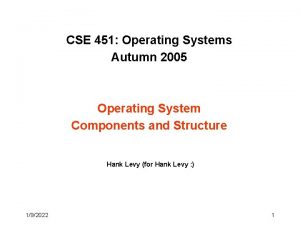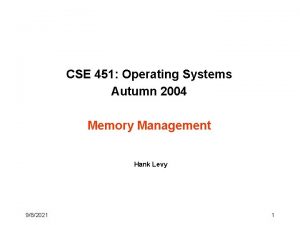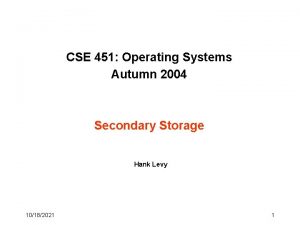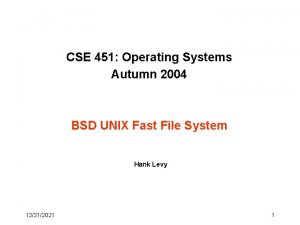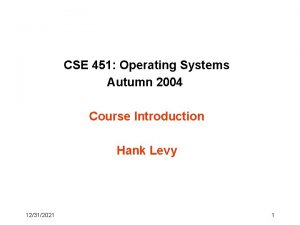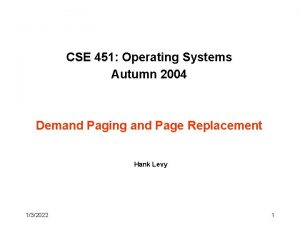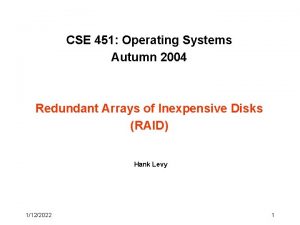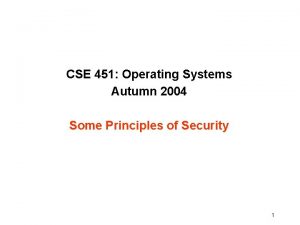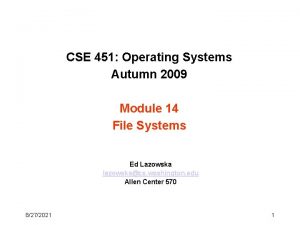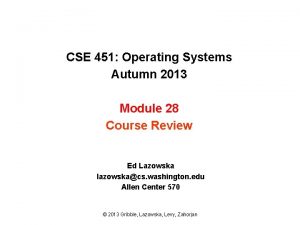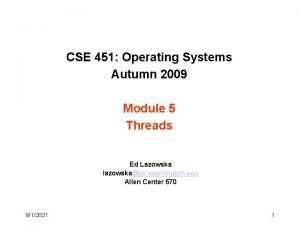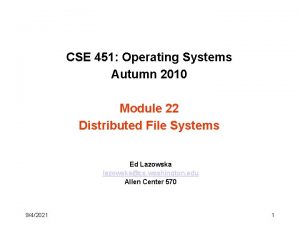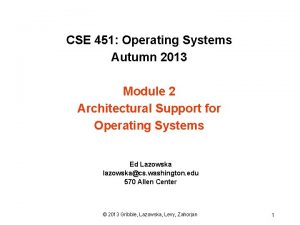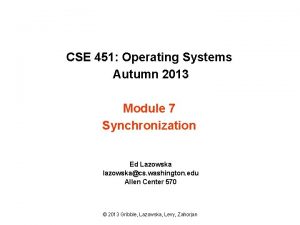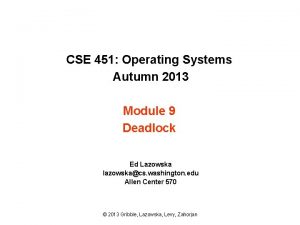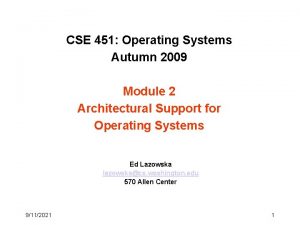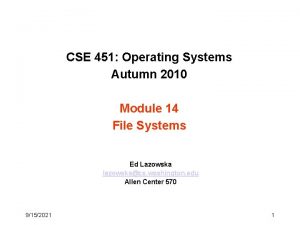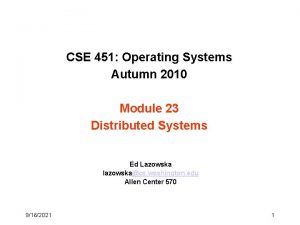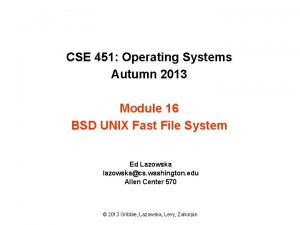CSE 451 Operating Systems Autumn 2004 Module 2


























- Slides: 26

CSE 451: Operating Systems Autumn 2004 Module 2 Architectural Support for Operating Systems Hank Levy 9/13/2021 1

Even coarse architectural trends impact tremendously the design of systems • Processing power – doubling every 18 months – 60% improvement each year – factor of 100 every decade 9/13/2021 © 2004 Ed Lazowska & Hank Levy 2

• Primary memory capacity – same story, same reason (Moore’s Law) • I remember pulling all kinds of strings to get a special deal: 512 K of VAX-11/780 memory for $30, 000 • today: 9/13/2021 © 2004 Ed Lazowska & Hank Levy 3

• Disk capacity, 1975 -1989 – – doubled every 3+ years 25% improvement each year factor of 10 every decade Still exponential, but far less rapid than processor performance • Disk capacity since 1990 – – doubling every 12 months 100% improvement each year factor of 1000 every decade 10 x as fast as processor performance! 9/13/2021 © 2004 Ed Lazowska & Hank Levy 4

• Only a few years ago, we purchased disks by the megabyte (and it hurt!) • Today, 1 GB (a billion bytes) costs $1 from Dell (except you have to buy in increments of 20 GB) – => 1 TB costs $1 K, 1 PB costs $1 M • In 3 years, 1 GB will cost $. 10 – => 1 TB for $100, 1 PB for $100 K 9/13/2021 © 2004 Ed Lazowska & Hank Levy 5

• Optical bandwidth today – – – Doubling every 9 months 150% improvement each year Factor of 10, 000 every decade 10 x as fast as disk capacity! 100 x as fast as processor performance!! • What are some of the implications of these trends? – Just one example: We have always designed systems so that they “spend” processing power in order to save “scarce” storage and bandwidth! – What else? 9/13/2021 © 2004 Ed Lazowska & Hank Levy 6

9/13/2021 © 2004 Ed Lazowska & Hank Levy 7

9/13/2021 © 2004 Ed Lazowska & Hank Levy 8

9/13/2021 © 2004 Ed Lazowska & Hank Levy 9

9/13/2021 © 2004 Ed Lazowska & Hank Levy 10

9/13/2021 © 2004 Jim. Ed Gray, Lazowska Microsoft & Hank Corporation Levy 11

Lower-level architecture affects the OS even more dramatically • Operating system functionality is dictated, at least in part, by the underlying hardware architecture – includes instruction set (synchronization, I/O, …) – also hardware components like MMU or DMA controllers • Architectural support can vastly simplify (or complicate!) OS tasks – e. g. : early PC operating systems (DOS, Mac. OS) lacked support for virtual memory, in part because at that time PCs lacked necessary hardware support • Apollo workstation used two CPUs as a bandaid for nonrestartable instructions! – Current Intel-based PCs still lack support for 64 -bit addressing (which has been available for a decade on other platforms: MIPS, Alpha, IBM, etc…) • this will change mostly due to AMD’s new 64 -bit architecture 9/13/2021 © 2004 Ed Lazowska & Hank Levy 12

Architectural features affecting OS’s • These features were built primarily to support OS’s: – – – – timer (clock) operation synchronization instructions (e. g. , atomic test-and-set) memory protection I/O control operations interrupts and exceptions protected modes of execution (kernel vs. user) protected instructions system calls (and software interrupts) 9/13/2021 © 2004 Ed Lazowska & Hank Levy 13

Protected instructions • some instructions are restricted to the OS – known as protected or privileged instructions • e. g. , only the OS can: – directly access I/O devices (disks, network cards) • why? – manipulate memory state management • page table pointers, TLB loads, etc. • why? – manipulate special ‘mode bits’ • interrupt priority level • why? – halt instruction • why? 9/13/2021 © 2004 Ed Lazowska & Hank Levy 14

OS protection • So how does the processor know if a protected instruction should be executed? – the architecture must support at least two modes of operation: kernel mode and user mode • VAX, x 86 support 4 protection modes • why more than 2? – mode is set by status bit in a protected processor register • user programs execute in user mode • OS executes in kernel mode (OS == kernel) • Protected instructions can only be executed in the kernel mode – what happens if user mode executes a protected instruction? 9/13/2021 © 2004 Ed Lazowska & Hank Levy 15

Crossing protection boundaries • So how do user programs do something privileged? – e. g. , how can you write to a disk if you can’t do I/O instructions? • User programs must call an OS procedure – OS defines a sequence of system calls – how does the user-mode to kernel-mode transition happen? • There must be a system call instruction, which: – causes an exception (throws a software interrupt), which vectors to a kernel handler – passes a parameter indicating which system call to invoke – saves caller’s state (regs, mode bit) so they can be restored – OS must verify caller’s parameters (e. g. , pointers) – must be a way to return to user mode once done 9/13/2021 © 2004 Ed Lazowska & Hank Levy 16

A kernel crossing illustrated Netscape: read( ) user mode trap to kernel mode; save app state kernel mode trap handler find read( ) handler in vector table restore app state, return to user mode, resume read( ) kernel routine 9/13/2021 © 2004 Ed Lazowska & Hank Levy 17

System call issues • What would happen if kernel didn’t save state? • Why must the kernel verify arguments? • How can you reference kernel objects as arguments or results to/from system calls? 9/13/2021 © 2004 Ed Lazowska & Hank Levy 18

Memory protection • OS must protect user programs from each other – maliciousness, ineptitude • OS must also protect itself from user programs – integrity and security – what about protecting user programs from OS? • Simplest scheme: base and limit registers – are these protected? Prog A Prog B Prog C 9/13/2021 base reg limit reg base and limit registers are loaded by OS before starting program © 2004 Ed Lazowska & Hank Levy 19

More sophisticated memory protection • coming later in the course • paging, segmentation, virtual memory – page tables, page table pointers – translation lookaside buffers (TLBs) – page fault handling 9/13/2021 © 2004 Ed Lazowska & Hank Levy 20

OS control flow • after the OS has booted, all entry to the kernel happens as the result of an event – event immediately stops current execution – changes mode to kernel mode, event handler is called • kernel defines handlers for each event type – specific types are defined by the architecture • e. g. : timer event, I/O interrupt, system call trap – when the processor receives an event of a given type, it • • 9/13/2021 transfers control to handler within the OS handler saves program state (PC, regs, etc. ) handler functionality is invoked handler restores program state, returns to program © 2004 Ed Lazowska & Hank Levy 21

Interrupts and exceptions • Two main types of events: interrupts and exceptions – exceptions are caused by software executing instructions • e. g. , the x 86 ‘int’ instruction • e. g. , a page fault, write to a read-only page • an expected exception is a “trap”, unexpected is a “fault” – interrupts are caused by hardware devices • e. g. , device finishes I/O • e. g. , timer fires 9/13/2021 © 2004 Ed Lazowska & Hank Levy 22

I/O control • Issues: – how does the kernel start an I/O? • special I/O instructions • memory-mapped I/O – how does the kernel notice an I/O has finished? • polling • interrupts • Interrupts are basis for asynchronous I/O – device performs an operation asynch to CPU – device sends an interrupt signal on bus when done – in memory, a vector table contains list of addresses of kernel routines to handle various interrupt types • who populates the vector table, and when? – CPU switches to address indicated by vector specified by interrupt signal 9/13/2021 © 2004 Ed Lazowska & Hank Levy 23

Timers • How can the OS prevent runaway user programs from hogging the CPU (infinite loops? ) – use a hardware timer that generates a periodic interrupt – before it transfers to a user program, the OS loads the timer with a time to interrupt • “quantum”: how big should it be set? – when timer fires, an interrupt transfers control back to OS • at which point OS must decide which program to schedule next • very interesting policy question: we’ll dedicate a class to it • Should the timer be privileged? – for reading or for writing? 9/13/2021 © 2004 Ed Lazowska & Hank Levy 24

Synchronization • Interrupts cause a wrinkle: – may occur any time, causing code to execute that interferes with code that was interrupted – OS must be able to synchronize concurrent processes • Synchronization: – guarantee that short instruction sequences (e. g. , read-modify -write) execute atomically – one method: turn off interrupts before the sequence, execute it, then re-enable interrupts • architecture must support disabling interrupts – another method: have special complex atomic instructions • read-modify-write • test-and-set • load-linked store-conditional 9/13/2021 © 2004 Ed Lazowska & Hank Levy 25

“Concurrent programming” • Management of concurrency and asynchronous events is biggest difference between “systems programming” and “traditional application programming” – modern “event-oriented” application programming is a middle ground • Arises from the architecture • Can be sugar-coated, but cannot be totally abstracted away • Huge intellectual challenge – Unlike vulnerabilities due to buffer overruns, which are just sloppy programming 9/13/2021 © 2004 Ed Lazowska & Hank Levy 26
 Module 4 operating systems and file management
Module 4 operating systems and file management Cse 451
Cse 451 Cse 451
Cse 451 C device module module 1
C device module module 1 Operating system sample
Operating system sample Evolution of operating systems
Evolution of operating systems Components of an operating system
Components of an operating system Os components
Os components Wsn operating systems
Wsn operating systems Operating systems three easy pieces
Operating systems three easy pieces Operating system lab
Operating system lab What is dual mode in os
What is dual mode in os Operating systems structure
Operating systems structure What are the main components of file management
What are the main components of file management Design issues in distributed system
Design issues in distributed system Early operating systems
Early operating systems Real-time operating systems
Real-time operating systems Can we make operating systems reliable and secure
Can we make operating systems reliable and secure Alternative operating systems
Alternative operating systems Exokernel operating system
Exokernel operating system Operating system internals and design principles
Operating system internals and design principles Operating system evolution
Operating system evolution Give examples of nos network operating system
Give examples of nos network operating system Msdn subscription levels
Msdn subscription levels Hobbyist operating system
Hobbyist operating system Real time characteristics of embedded operating systems
Real time characteristics of embedded operating systems Operating systems concepts
Operating systems concepts

